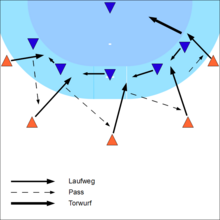Parallel impact
The parallel strike is a fundamental element of the game of handball .
It is one of the basic group tactical elements when learning positional play after you have mastered the ball in the forward movement with sufficient confidence. In the case of a parallel strike, the attacking players do not leave their playing position, but it is the basis for the effective implementation of further group tactical attacking actions such as crossing or blocking , in which the attacking players change position (position change game). The parallel push can be used particularly effectively in the game of excess numbers.
procedure
The ball carrier (usually the left or right winger ) runs into the gap between two opponents, so that both are forced to defend against the attacker. The additional tied defender creates a larger gap in front of the neighboring attacker, who at that moment runs into the gap parallel to the attacker carrying the ball ("pushes"), is played and thus binds another opponent. This is continued to the opposite side, where the full-back has to defend against the attacking half-player and thus the outside attacker is free and can throw at goal .
Alternatively, the player starting the parallel shot can run into the gap between the full-back and the edge of the field. On the one hand, this creates more free space, on the other hand, the defense is forced to pay more attention by varying the walking path.
literature
Arno Ehret, Dietrich Späte, Renate Schubert, Klaus Roth: handball manual . 3. Edition. tape 2 . Philippka-Sportverlag , Münster 1995, ISBN 3-89417-054-9 , p. 138 ff .
